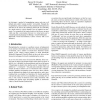Free Online Productivity Tools
i2Speak
i2Symbol
i2OCR
iTex2Img
iWeb2Print
iWeb2Shot
i2Type
iPdf2Split
iPdf2Merge
i2Bopomofo
i2Arabic
i2Style
i2Image
i2PDF
iLatex2Rtf
Sci2ools
SI3D
1995
ACM
1995
ACM
CamDroid: A System for Implementing Intelligent Camera Control
In this paper, a method of encapsulating camera tasks into well defined units called “camera modules” is described. Through this encapsulation, camera modules can be programmed and sequenced, and thus can be used as the underlying framework for controlling the virtual camera in widely disparate types of graphical environments. Two examples of the camera framework are shown: an agent which can film a conversation between two virtual actors and a visual programming language for filming a virtual football game.
| Added | 26 Aug 2010 |
| Updated | 26 Aug 2010 |
| Type | Conference |
| Year | 1995 |
| Where | SI3D |
| Authors | Steven M. Drucker, David Zeltzer |
Comments (0)

